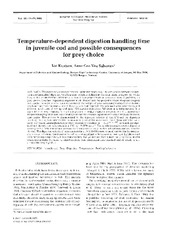| dc.description.abstract | The paper combines experimental work with modelling. The aim was to estimate the temperature-dependent digestion handling time, which is defined as the time taken to digest the whole prey or the whole stomach contents, and to examine potential consequences of prey digestibility on prey choice. A surface-dependent digestion model that reflects the geometric shape of a piscivore prey was applied to experimental data representing the weight of prey remaining undigested at various points in time from the time at which the prey was first ingested. The fish used were juvenile cod fed different meal sizes of two-spotted goby Gobjusculus flavescens Fabricius at 4 temperatures. It is assumed that prey digestion is a surface process in which digestive enzymes attack progressively deeper into a prey of known size and shape so that the average digestion rate would be proportional to prey radus. This process is characterized by the digestion velocity d, (cm h-') and the digestion handling time. d, was estimated for various meal sizes and temperatures. Next, these estlrnates were used to obtain a standardized temperature-dependent function: d, = dso[e~h34'"0)oTf ],which the standardized digestion velocity estimate at O°C, d, = 0.0026 cm h-' The d, relation expresses the digestion velocity over a 10-fold meal size increase for a temperature range within natural seasonal variation for the cod. The digestion velocity d, was constant for a 10-fold difference in meal size within the temperature range. However, the digestion handling time increased with increasing meal size, but decreased with increasing temperature. It was demonstrated that predictions from a modified prey choice model which incorporates the effect of digestion differ from predictions from classical models which do not account for prey digestion. | en_US |
